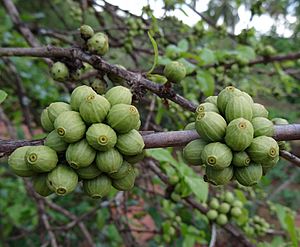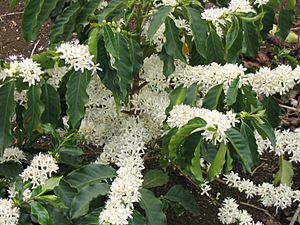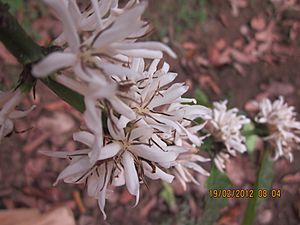Coffea facts for kids
Coffea is a group of flowering plants. Some of these plants produce special seeds called coffee beans. These beans are used to make many different coffee drinks and products. Coffea plants belong to the plant family called Rubiaceae. These plants are usually shrubs or small trees. They naturally grow in warm, tropical parts of Africa and Asia. Coffee is one of the most valuable and traded crops in the world. It is a very important export product for many countries, especially in Central and South America, the Caribbean, and Africa. ContentsGrowing and Using Coffee PlantsMany types of Coffea plants can be grown for their seeds. The most common type is Coffea arabica, which makes up about 75-80% of all coffee grown worldwide. Another important type is Coffea canephora, which accounts for about 20% of global coffee production. Coffee trees grow tasty red or purple fruits. These fruits are often called "cherries." Inside each cherry, you usually find two seeds. These seeds are what we call "coffee beans." Even though they are called beans, they are not true beans like the ones you eat. Sometimes, in about 5-10% of coffee cherries, there is only one bean instead of two. This special bean is called a peaberry. Peaberries are smaller and rounder than regular coffee beans. They are often separated and sold on their own, like the New Guinea peaberry. When grown in warm, tropical areas, coffee plants are strong bushes or small trees. They usually grow to be about 3 to 3.5 meters (10 to 11.5 feet) tall. Most coffee plants grow best in high places, but they cannot handle freezing weather. The Coffea arabica tree starts to grow fruit after three to five years. It can then produce fruit for about 50 to 60 years, and sometimes even up to 100 years! The white flowers on the tree smell very nice. It takes about 9 months for the fruit to ripen. 
Fruits of Coffea racemosa
Coffee Plants in NatureThe caffeine found in coffee "beans" is a natural way for the plant to protect itself. It's like a toxic substance that helps keep the seeds safe from animals that might want to eat them. The fruits and leaves of the coffee plant also contain caffeine. You can even make a tea from the leaves, but this is not usually done for selling. Several insects can cause problems for coffee plants. These include the coffee borer beetle and the coffee leafminer. Some caterpillars (the young forms of Lepidoptera like butterflies and moths) also eat coffee plants. Examples include Dalcera abrasa and the turnip moth. New Discoveries About CoffeeScientists are always learning new things about coffee plants. In 2008 and 2009, researchers from the Royal Botanic Gardens, Kew found seven new types of Coffea plants. They found these in the mountains of northern Madagascar. In 2008, two more new species of coffee plants were found in Cameroon. One of them, called Coffea charrieriana, naturally has no caffeine! The other new species is Coffea anthonyi. By mixing these new types with other known coffee plants, scientists hope to create new coffee plants that don't have caffeine or that can pollinate themselves. In 2014, scientists mapped out the entire genome of the coffee plant. A genome is like a complete instruction book for how a living thing is built. They found over 25,000 genes in coffee. This research showed that coffee plants make caffeine using different genes than those found in tea or cacao plants. Images for kids
See also
|
||||||||||||||||||||||||||||||













 In Spanish:
In Spanish: